|
|
ON THE ROAD IN PERU
THE RENT-A-CAR WAY
by
ROBERT J. LEWIS

PREP
TALK
Of
the 340 or so disembarking passengers, we were the only ones
renting a car (Fiat Uno) at Lima’s International Airport.
I was surprised but not surprised. Without exception, the guide
books to Peru either quietly or explicitly counsel against it,
citing a litany of possible negative events, the majority of
which happen in our own big city backyards everyday.
Spectacular
ruins and wonderfully preserved Spanish colonial architecture
notwithstanding, the true story of Peru is the road. From the
majestic Atacama desert in the south, to the dune panoramas
between Lima and Trujillo in the near north, to the impossibly
fecund Thai-green Andes in the Cusco region, to the 4,000 meter
high Lake Titicaca and the fascinating life that generates from
it, Peru, with all due respect to Spain and Italy, is arguably
one of the most beautifully varied countries on the planet.
And the way to see it is by car. Exercising normal caution,
there is no good reason not to rent a car and take to the much
improved road network up and down Peru’s Pan-American
Highway and the many arteries that worm their way inland up
into the awesome Andes.
TO
BE CONSIDERED BEFORE RENTING FROM LIMA
- -
The guide books offer, at best, only cursory evaluation of Peru’s
gorgeous landscape because almost no one rents.
- -
The guide books offer no practical instruction on how to get
in and out of Lima, which is not only essential to your trip
but to the rest of your life. Without mincing words, Lima --
less Miraflores and a few other highly recommended areas --
is the anus of Peru. To the tune of eight million, the wretched
of the earth are gathered here, living in squalor the likes
of which I haven’t seen since India. If we are comfortable
in India, it’s because its poor have been ingeniously
pacified (anaesthetized) by religion and the promise of an afterlife.
There’s no such hocus pocus in Lima where the disenfranchised
live in windowless boxes plunked on the hard rock and sand of
the surrounding, desiccated hillsides, where running water and
electricity are in no supply -- and the crime rate is alarming.
Never forget that the nearness of your shoulder bag is the song
they can’t refuse – that if El Dorado is a myth
come to earth, you’re it.
Contrary
to your reading of the map, when leaving Lima’s airport
to go south, do not take Av. Peru for what seems like
the shortest route to the Pan-American Highway. Instead, take
Elmer Faucet to Av. La Marina to Javier Prado (about 30 kms)
which connects to the Pan-American South. If you’re heading
north, take Av. Tomas Valle to the Pan North (about 5 kms) .
From either direction, passing through Lima, you connect to
either the North or South by taking the Via de Evitamiento (like
the French éviter = to avoid). No matter how
deep is your atheism, a mistake here will have you reciting
prayers you didn’t know exist.
- -
You have to be comfortable driving a standard transmission,
ideally with some European-Alpine experience. And when the travelling
day is done, without exception, park your car in either your
hotel’s private parking (la cochera), or a secure,
nearby cochera.
-
- - It will help immensely if you can speak a little Spanish,
at least enough to ask for directions and catch the response.
Signs are practically non-existent in Peru and you’ll
be dependent on well intended instruction from a very hospitable
and helpful people.
- -
There are tolls everywhere in Peru, relatively expensive compared
to everything else. If in the local markets, a three-course
meal will set you back all of one Canadian dollar, tolls average
two bucks for every 75 kms. The system is unique and labor effective:
you’re charged on all roads leading away from Lima, which
are free in the opposite direction.
ON THE ROAD – EL SUR
We
logged 7,000 kms in just under a month. Leaving the capital
going south, you’ll immediately encounter mostly empty
desert landscape, some of which is miraculously under cultivation.
If this, the Atacama, is your first desert, you’ll be
impressed. But it doesn’t compare to the Chilean Atacama,
nor for that matter the Sahara in the Touggart-El Oued region
of Algeria. The Chilean desert is so dry and utterly lifeless,
that after 4,000 kms there wasn’t a single squashed insect
on our windshield. Furthermore, unlike the eerie, other worldly
route from San Pedro de Atacama to Antofagasta in Chile, the
flattish desert region south of Lima simply isn’t ugly
enough to be fascinating. But from time to time, you’ll
light upon some excellent desert moments as the road winds its
way through high dunes, picking up the sea at the 600 km point
at Puerta Inca all the way to Camana, 855 kms. Evaluating this
road (always on a scale of one to three) this latter section
merits a 2.5 while the first 600 kms a 1.8. Bear in mind the
universal tendency to fairly or unfairly compare one’s
immediate landscape to what one has just seen, which is probably
why the entire world outside of Canada strikes me as extraordinarily
beautiful.
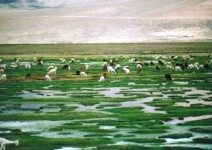 From
Camana, the road climbs uneventfully – again compared
to the eye opening southern version in Chile (Arica through
Putre to the Bolivian border) -- to Arequipa, 2,600 meters high.
But from Arequipa to Chivay (3,800 meters), and a visit to the
must-see Colca Valley, you’ll discover the essential pulchritude
and lush verdancy of the Andes on an aesthetic scale and grandeur
with which very few places on the planet can compete. From
Camana, the road climbs uneventfully – again compared
to the eye opening southern version in Chile (Arica through
Putre to the Bolivian border) -- to Arequipa, 2,600 meters high.
But from Arequipa to Chivay (3,800 meters), and a visit to the
must-see Colca Valley, you’ll discover the essential pulchritude
and lush verdancy of the Andes on an aesthetic scale and grandeur
with which very few places on the planet can compete.
From
Arequipa to Chivay (where you access the Colca) you arrive at
a junction (at 100 kms) that leaves you about 90 kms from Chivay.
The first 25 kms of this road are dirt, with lots of sharp rocks.
In our small car, it was barely doable as we slowed down to
15 kms/hour, always trying to keep to the smoother side. The
remaining 65 kms are mostly newly paved. This entire route however,
fog and mist permitting, is enchanted, leavened with llamas
and alpacas grazing on grass and drinking from glacial pools
only the gods could have provided for. The journey from Chivay
to the Colca Canyon’s Condor Lookout will run you about
100 kms, but after Yanqui – an atmospheric town with a
quaint plaza, 10 kms past Chivay – the road turns horrible
and we had to stop. Our criterion for risking dirt roads is
the absolute fear and dread of having to change a flat.
From
Chivay, back to the junction, the excellent road to Juliaca
(4 hours) rates a 2.8 with many extended 3 sections. Don’t
leave yourself short on film here, or for the next 1,200 kms
for that matter. Parts of this road rank with anything I have
ever seen, especially around the ¾ point where we happened
upon an exquisitely shaped, pristine lake surrounded by smooth,
pastel green mountains that you can’t imagine being bettered
by Lake Titicaca.
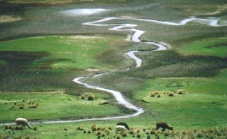 The
100 kms from Juliaco to Puno are surprisingly lackluster, especially
in light of what has just preceded. In Juliaca, you’ll
be taken aback by a preponderance of mostly motor drawn rickshaws.
By this time, you’ll have realized that the rules of the
road don’t exist in Peru: heavy traffic does not necessarily
keep to the right lane while the vehicle in front of you does
as it pleases. From time to time you’ll find yourself
driving on whatever side of the road is most effective, swerving
in and out of traffic as if you were in India. However disconcerting
this sounds, unless you are latently homicidal or long for an
extended period of exotic incarceration, you will make that
swerve on each and every occasion. The
100 kms from Juliaco to Puno are surprisingly lackluster, especially
in light of what has just preceded. In Juliaca, you’ll
be taken aback by a preponderance of mostly motor drawn rickshaws.
By this time, you’ll have realized that the rules of the
road don’t exist in Peru: heavy traffic does not necessarily
keep to the right lane while the vehicle in front of you does
as it pleases. From time to time you’ll find yourself
driving on whatever side of the road is most effective, swerving
in and out of traffic as if you were in India. However disconcerting
this sounds, unless you are latently homicidal or long for an
extended period of exotic incarceration, you will make that
swerve on each and every occasion. 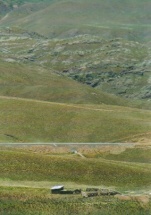 Juliaca
is a dirty city under extensive renovation, with cratered roads,
whose main streets are lined with antiquated North American
sewing machines for sale, the fact of which merits an economic
digression. Peru, at $5,600 per capita income, is a major garment
manufacturer, whose cheap labor is being undercut by the even
cheaper labor in China. So in order not to lose the remaining
threads of whatever competitive advantage remains, Peru is obliged
to buy up western discards at currency-friendly prices. Juliaca
is a dirty city under extensive renovation, with cratered roads,
whose main streets are lined with antiquated North American
sewing machines for sale, the fact of which merits an economic
digression. Peru, at $5,600 per capita income, is a major garment
manufacturer, whose cheap labor is being undercut by the even
cheaper labor in China. So in order not to lose the remaining
threads of whatever competitive advantage remains, Peru is obliged
to buy up western discards at currency-friendly prices.
Your
first rendezvous with Lake Titicaca begins in Puno. You’ll
stay there for practical, not aesthetic reasons: access to Lake
Titicaca’s many islands (most of which are worth a visit),
and the unforgettable drive around the southern swing of the
lake to the 2-star Bolivian town of Copacabana, which is 10
kms across the border.
Lake
Titicaca, at 3,800 meters, is not only the world’s highest
navigable lake, but is as large as Switzerland. Its hypnotic,
ink-blue surface is impenetrable, and its limitless horizon
as sharp as the edge of a knife. And while our textbooks teach
us from our earliest years that the earth is round, my experience
on Titicaca reminded me that science cannot explain everything.
From
that very first glimpse that is forever etched in my mind, the
lake’s razored horizon was so riveting, I knew I had to
go there and see it in the flesh, so with a guide and small
boat, we ventured out one brisk morning and sure enough, as
if there were never any doubt, we rowed right up to the edge
of what we knew not, where I dared to look over -- and found
myself gazing into the very face of the Godhead. My boatman
also looked over but did not see what I saw, and what he said
as he disappeared over the edge I shall never repeat.
Like
a benevolent deity, the lake is revered for the agriculture
it sustains and the communal life that hasn’t changed
in centuries. The region’s unhurried rhythms are so natural,
I would often find myself wondering why some cultures advance
technologically while others don’t, and provisionally
concluded that the fortuitous presence of an extraordinary genius
can make all the difference. 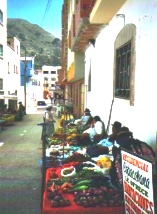 It’s
now a couple of months since I’ve been back in my quotidian,
but from time to time, as if reliving a dream that cannot survive
the morning’s first light, I catch myself harkening back
to that idyllic, pastoral tempo that unfolds around Lake Titicaca,
and I realize how privileged I felt to have been given the extraordinary
opportunity to bear witness to a spirit and civilization that
does not compare to the fast pace and cacophony of my own, and
cannot help but to wonder if the offspring of genius –
progress -- is a blessing or a curse. It’s
now a couple of months since I’ve been back in my quotidian,
but from time to time, as if reliving a dream that cannot survive
the morning’s first light, I catch myself harkening back
to that idyllic, pastoral tempo that unfolds around Lake Titicaca,
and I realize how privileged I felt to have been given the extraordinary
opportunity to bear witness to a spirit and civilization that
does not compare to the fast pace and cacophony of my own, and
cannot help but to wonder if the offspring of genius –
progress -- is a blessing or a curse.
Juliaca
to Cusco (350 kms) constitutes yet another monumental route.
The first 70 kms of this paved, but pot-holed road take you
through velvety, undulating mountains that leave you convinced
that there is indeed a place reserved for heaven on earth, and
that the deity you’ve been looking for is just around
the next turn. From km 150 to 225, the landscape turns Alpinish,
with cultivated mountain sides running down into luxuriant valleys
that feature both thatched and terracotta roofing. As if providing
the perfect solution to urban congestion, the villages and their
green spaces, over a 75 km stretch, are seamlessly connected,
eventually surrendering to the higher mountains of the Cusco
region. This heavenly highway rates a 2.7 with many 3 sections.
From
Cusco, there are many small side trips, all of which are breathtaking.
Leaving the city northward, you visit the Inca ruins at Sacayhuaman,
where you’ll discover first hand why the Incas are regarded
as history’s greatest stone cutters. From there, this
lush-with-life road that recalls Old Europe twists its way to
the ruins of Pisaq (about 45 kms), cul de sac-ing half way up
a mountain. It would be hard to find a more satisfying view:
everything is ‘here, there, and everywhere.’ Looking
up, the eye follows delightful pathways leading to three separate
sites of well preserved ruins. 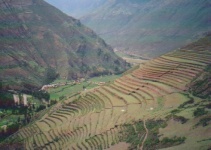 Straight
ahead lies an exquisitely cut terrace that elegantly cascades
to the valley below, each tablet velvet green and as smooth
as fur. Looking down, the eye is treated to a Braque-like tableau
of sun baked terracotta roofs backed up by deep green, flourishing
mountain flanks. If Machu Pichu can beat this, show me. Straight
ahead lies an exquisitely cut terrace that elegantly cascades
to the valley below, each tablet velvet green and as smooth
as fur. Looking down, the eye is treated to a Braque-like tableau
of sun baked terracotta roofs backed up by deep green, flourishing
mountain flanks. If Machu Pichu can beat this, show me.
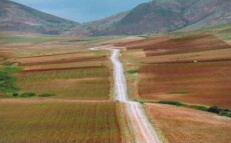 Continuing
from Pisaq to Urubumba is another princely 2.6 drive, and from
Urubumba going south, at the 10 km point, the road forks right
to Maras, where a difficult 7 km, 3-star dirt road cuts through
preternaturally serene, sienna-brown, Basque-red landscape that
recalls Andalusia (Antiquera region), conducting you into a
brawny, bouldered gorge where an implausibly extensive cache
of salt terraces reside in their luminous, cubist splendor.
Once again, don’t leave yourself short of film here. From
Maras back to the main road, a less difficult but quietly awe-inspiring
10 km dirt road drops you off at Moray, another worthwhile site. Continuing
from Pisaq to Urubumba is another princely 2.6 drive, and from
Urubumba going south, at the 10 km point, the road forks right
to Maras, where a difficult 7 km, 3-star dirt road cuts through
preternaturally serene, sienna-brown, Basque-red landscape that
recalls Andalusia (Antiquera region), conducting you into a
brawny, bouldered gorge where an implausibly extensive cache
of salt terraces reside in their luminous, cubist splendor.
Once again, don’t leave yourself short of film here. From
Maras back to the main road, a less difficult but quietly awe-inspiring
10 km dirt road drops you off at Moray, another worthwhile site.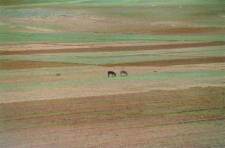
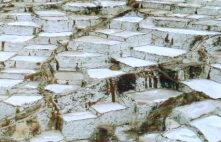 If
you decide to take the train from Ollantaytambo instead of Cusco
to Machu Pichu, the route and the town’s authentic charm
are the reasons. If
you decide to take the train from Ollantaytambo instead of Cusco
to Machu Pichu, the route and the town’s authentic charm
are the reasons.
Machu
Pichu, even at a $105 Can/person, didn’t disappoint and
ranks, along with Iguazu Falls, as the single most inspiring
site I have ever witnessed.
The
steep ascent from Cusco through Abancay to Nazca takes 12 hours
and should be done in two days. On a newly paved, serpentine
highway from Cusco to Abancay you’ll climb to 4,500 meters,
but you’re in the tropics, so instead of snow you’ll
be bowled over by the rice-paddy-green that characterizes the
vast cultivation that makes this one of the richest agricultural
areas in all of Peru. You’ll pass mango groves such as
you have never seen, as well as papaya and banana plantations.
This route merits a 3. Exiting Abancay, you pass through a 150
mile gorge after which the road gradually rises to 4,800 meters:
that’s more than half way up Everest making it one of
the word’s highest paved highways. The views are of the
stuff that make jaws drop, and at the very top, the mist-wreathed
landscape is lunar -- a cold mix of glacial detritus, water
puddles and stubble, and winter-garbed, Quecha-speaking herdsman
trying to eke out a living raising alpacas. At Puquio (two long
hours from Nazca), where the paved road stops for about 5 horrendous
kms, you descend to 500 meters and a route that winds and twists
its way through sun-lashed, broke-back dry mountains that are
weathered down into small stone and sand as Nazca appears like
a desert mirage – which it isn’t. This long section
rates a 2.6, with 3s in the memorable upper reaches where the
gods reside and clouds cling to the dew and valleys below.
This
concludes the southern swing. The 1,800 kms from Chivay to Lake
Titicaca on through Cusco to Nazca must surely constitute one
of the world’s most extraordinary and varied long drives
where you’ll be hard pressed to find a single dull kilometer.
And I say this having driven far and high and wide(eyed).
ON
THE ROAD – EL NORTE
Heading
north from Lima to Trujillo (570 kms), the desert, surprisingly,
is more formidable than south of the capital. This section merits
a 2 with several 2.7 stretches: in particular from Casco to
Huarmey, an excellent stop-over town. On the way to Trujillo,
you have to persevere through the degraded city of Chimbote.
At its best, the place is merely ugly, at its worst, the rickshaw
overrun outskirts are strewn with garbage and attendant pickers
and squatters. Chimbote rudely reminds you that garbage disposal
in Peru is not a science. Seventy kilometers before Trujillo,
one of Peru’s many desert marvels begin. Like the Israelis,
the Peruvians make things grow out of sand. The result boggles
the disbelieving eye as you drive past rice paddies, sugar cane
fields and a poorly paid workforce at play in the fields of
the lord. Where the desert hasn’t been tamed, you’ll
observe heavy machinery cutting deep and wide furrows out of
the sand into which bags of manure are spilled.
After
Trujillo, the desert begins to flatten out as do the Andes on
your right. Here, the true north begins, featuring more prosperous
towns and cities. The route from Trujillo to Chiclayo is mostly
flat and dull, the same from Chiclayo to Piura. However 15 kms
before Piura, scrub begins to appear, and then low shrub and
trees, and then a string of desert defying villages lording
over huts made of thatched bamboo. If it’s Sunday, the
locals will be vested in their domingo best, trudging
over the low dunes to their simple places of worship. At Sulliana
(45 kms north of Piura), the road veers seaward to Talara where
coconut groves suddenly appear and disappear. For the next 50
kms, the road is mostly flat desert, eventually giving way bare,
shriven, hills that turn into low mountains as the road hugs
the coast through Mancora to Tumbes. The drive from Chiclayo
to Sulliana weighs in at 1.5, from Sulliana to Tumbes a respectable
2.
There
are four inland routes between Lima and Tumbes, for which we
only had time for one. They say the Lima-La Oroya route is the
most spectacular. Less recommended is the road from Chiclayo
to Jaen. The route from Casma to Huaraz isn’t paved, so
we decided on the 2.7 route from Pacasmayo to Cajamarca.
If
it’s variety you’re looking for, the road from the
coast to Cajamarca has it all. This four hour feast follows
a river that is fed by mountain runoff all year long. The first
50 kms feature lush, labor intensive rice fields and mango trees
whose branches are bowed by the weight of their bounty. On both
sides of the river and the fertile plain that hugs it are dry
gorges and sun blistered cliff sides, their muscled colors ranging
from clay pot brown to burnt sienna. 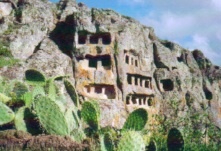 At
the 100 km point the road begins to ascend in earnest as the
mountains turn deliciously green. The climb rises to 3,000 meters
before dipping to 2,700 and the preciously placed city of Cajamarca
where you’ll be based. At
the 100 km point the road begins to ascend in earnest as the
mountains turn deliciously green. The climb rises to 3,000 meters
before dipping to 2,700 and the preciously placed city of Cajamarca
where you’ll be based.
Unfolding
like a pastoral is the impressive 10 km drive from Cajamarca
to the fabulous funerary tombs of Ventanillas de Otusco. The
tombs, and there are hundreds of them, have been dug out of
the mountain side whose lower flank features a natural cactus
garden and a charming path that leads you to the sun-tempered,
amber tinted cliff side.
POSTSCRIPT
I believe
the reason we travel (as opposed to going on vacation), and
endure hardship and risks real travel often entails, is to expose
the arbitrariness of the cultural imperatives that inform our
tastes and preferences. We willingly submit to a kind of mental
aerobics, painful mind-stretching exercises that force us to
accommodate and embrace worlds very different than our own.
And at the end of the voyage, when the day is done, the suitcase
unpacked, we’re not so much wiser as more generous in
our judgments and sympathetic to the necessarily rude choices
some people have to make.
While
every region in the world can argue its case for beauty, some
places are categorically more pulchritudinous than others, and
Peru is one of them. There were at least 10 occasions where
I was simply overcome, emotionally surfeited by the natural
beauty of my surroundings; and when giving thanks, that thought
always included a nod to the irrational side of me that had
the good sense and temerity to throw guidebook-caution to the
wind and take to the road. For unless you have a year or two
and boots made for walking, there’s no better way to unravel
the marvels and mystery of Peru than by car.
From
its aesthetic order to eating habits to market place customs,
time spent in Peru turned my conceits about life into questions
I would otherwise have never asked. For example, from dawn until
dusk, in the garb of its womenfolk, Peru is a festival of colors
and color combinations that makes no sense in our part of the
world but perfect sense in the context of an ethos that unfolds
as naturally and unconsciously as our own – at least for
the time being. Sadly, irreversibly, the color paradigm that
has been synonymous with Peru for centuries is disappearing
under the onslaught of Western culture; and what excites the
traveller today will probably not exist 50 years from now --
outside of the museum.
Those
of you now persuaded to take to the incomparable highways and
byways of a country precariously perched between its present
and future, I promise that by the time you get to Lake Titicaca,
you will have already submitted my name for apotheosis. Less
than that, I await your feedback. Buen viaja.
|
|
|